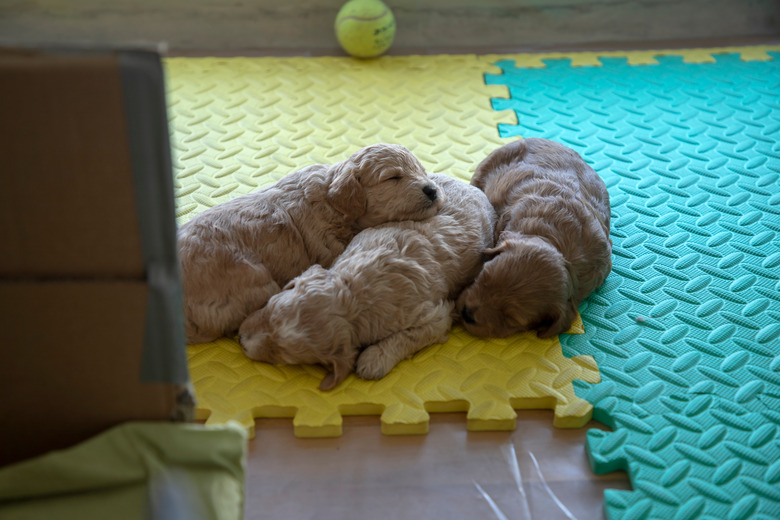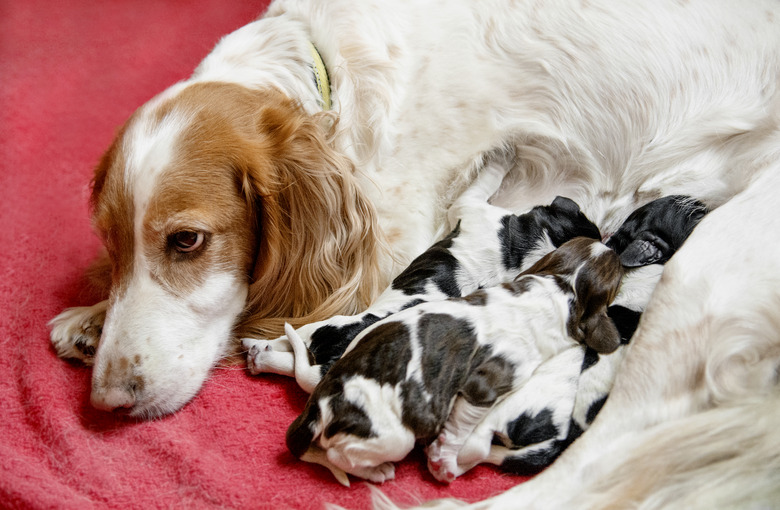How To Prepare For The Birth Of A Litter Of Puppies
If you have a pregnant dog to care for, you need to prepare for the birth of a litter of puppies. This involves not just taking care of the mother but setting up adequate space in your house and ensuring you are ready to care for the newborn puppies. If this is your dog's first litter or your first time caring for a pregnant dog, it's important to know what signs to look for. Preparing ahead of time can help you ensure your dog and her young are healthy and comfortable.
You will also need to be prepared for the expense and commitment a litter of puppies entails. Dog overpopulation is a significant, widespread problem. You'll need to find responsible, lifelong homes for all the puppies. Both the mother dog and her puppies will need ongoing medical care, and puppies will need to start their deworming and vaccine schedules before going to new homes.
How long are dogs pregnant?
How long are dogs pregnant?
Gestation is an average of 63 days, or nine weeks, depending on the breed. Although dog pregnancies are shorter than those of humans, they also consist of trimesters. In dogs, each trimester is three weeks.
Signs of pregnancy in dogs
Signs of pregnancy in dogs
If you suspect your dog is pregnant, you will want to take her to the veterinarian for diagnostic testing to confirm it. These include:
- Weight gain
- Swollen stomach
- Increased appetite
- Enlarged nipples
- Irritability
- Increased affection
- More easily fatigued
- Decreased activity
- Vomiting (first trimester)
- Nesting behaviors
How to prepare for a litter of puppies
How to prepare for a litter of puppies
Much of the process of birthing and caring for new puppies is instinctual to mother dogs, but there are steps you can take to support your female dog and the litter of pups. If at any point in the process a problem does occur, contact your veterinarian for help.
Take the mother dog to the veterinarian
Take the mother to the veterinarian and have her checked out. Your veterinarian will discuss a plan to keep her in optimal health leading up to the birth.
Preventative measures, like flea treatments and heartworm preventatives, can be continued in most cases but discuss this with your veterinarian first. Mother dogs also have special dietary needs and will need to increase their daily calorie intake. Your veterinarian may recommend transitioning to a different dog food, such as a puppy food or growth formula.
After day 45 of gestation, take the mother dog to the veterinarian again for a checkup and abdominal X-rays to show how many puppies are present. This is important so you have an idea of how many to expect.
Alert your veterinarian if the mother starts giving birth prematurely or if she's showing no signs of labor a week after her due date. In the latter case, a veterinarian may need to induce labor or perform a cesarean section.
Set up a whelping box for the mother dog
A whelping box is usually a wooden box with low sides and sometimes a hinged "door" that acts as a ramp to the floor for when the puppies get older. The mother will give birth in the box (hopefully) and clean her puppies there as well.
Set up the whelping box in a room that is secure, quiet, and doesn't have bright lights or household traffic moving through it. Put a tarp or plastic drop cloth underneath and around the box in case of accidents and place soft bedding in the box for comfort. Ensure there are clean towels handy as well.
In the last three weeks of pregnancy, isolate the mother dog from all other dogs to prevent stress and any infections that could be passed along to the puppies. This is also important because older dogs may be territorial or jealous and attack the puppies.
Encourage the pregnant dog to use the box regularly
Help her get used to being in the whelping box by encouraging her to sleep and sit there. If you install a heat lamp or heating pad, that might make her more likely to go in it, and it will also help the puppies retain body heat after they're born. Puppies cannot regulate their own body temperature in the first few weeks of life.
If you use a heat lamp or heating pad, make sure it only covers part of the whelping box area and that there is plenty of room for the mother and puppies to get away from the heat. Burns and hyperthermia can result from heat lamp and heating pad exposure, so it must be monitored. Make sure there is always padding, such as a towel, between the heating pad and the puppies and mother dog, and it never contacts them directly. Burns can occur quickly from heating pads.
Research the signs of labor in dogs
Examples include loss of appetite, restlessness, and sometimes vomiting as well as a decrease in rectal temperature. Normally, dogs' temperatures are between 101 and 102 degrees Fahrenheit, but within 24 hours of labor, the temperature drops below 100 degrees. Other signs of labor may appear about 12 hours before active labor.
Research potential complications as well. For example, you'll need to count the placentas as they come out; there should be one after each puppy. If a placenta stays inside the mother's womb or birth canal, this can lead to a dangerous situation.
Also, if the mother doesn't break the amniotic sac around the puppy right after birth, you need to break it for her and help the puppy start breathing. If the mother does not chew through the umbilical cord herself, you will need to cut it.
Remain close by and observe for any issues during labor If any problems occur, call your veterinarian immediately.
Check on your pregnant dog when she goes into labor
Puppies should start to arrive about an hour after she starts active labor. Keep an eye on her but don't bother her; animals know how to take care of their young instinctively. Make sure she has water available. Take a phone with you and your veterinarian's phone number in case you need to call for help.
You should see the first puppy come out within 30 minutes of green discharge produced by the mother dog. After that, one puppy should be born every 45 to 60 minutes.
Dogs may take up to a four-hour break in the middle of labor. If this break lasts longer and you know there are more puppies coming, call your veterinarian. Also call your veterinarian if the mother is straining for more than 30 to 60 minutes or seems to be in pain.
Where should your new puppies sleep at night?
Where should your new puppies sleep at night?
The puppies should sleep in the whelping box for at least the first three weeks. The mother should stay with them except to stretch her legs, eat, and eliminate waste.
What should I do if my newborn puppy is sick?
What should I do if my newborn puppy is sick?
If a puppy appears unwell, consider it an emergency and call a veterinarian immediately. Puppies are very vulnerable to illness and stress in their first few weeks of life.
Signs to look for include difficulty breathing, failure to gain weight, lack of appetite, crying, and hyperthermia or hypothermia. You can weigh the puppies with a kitchen scale and use a puppy-safe thermometer to take their temperature.
Even if all the puppies are healthy, it is necessary to take the mother and her litter to the veterinarian for a post-natal checkup within 48 hours after birth.
The bottom line
The bottom line
Supporting your pregnant dog throughout the gestation, birth, and postnatal process is one of the biggest responsibilities you will face as a pet parent. Taking your pregnant dog to the veterinarian for regular checkups, researching the pregnancy and birthing process, and understanding how to care for your dog and her litter after the birth is essential. Talk to your veterinarian about the best time to get your dog spayed after her puppies have been weaned.


